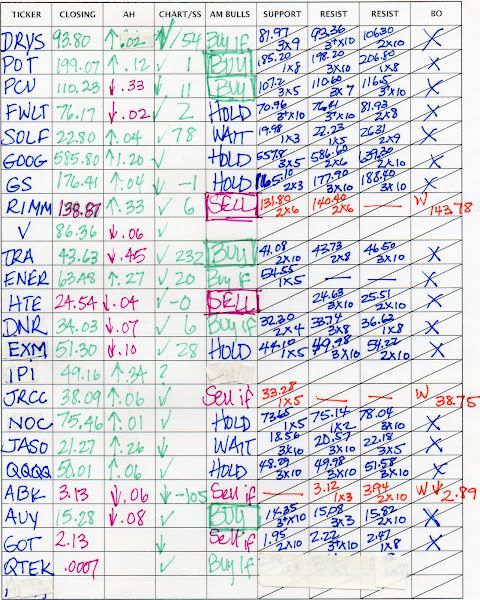I have been investing online for as many years as I have had access to the internet. Due to budgeting and time constraints I was limited to *DRIP types of investments, where I would pick a stock, and then invest a particular dollar amount at the same time each month resulting in dollar cost averaging of my stocks. What I found was that with my limited knowledge of reading charts and financial reports, I was able to pick stocks that were winners a high percentage of the time. Up until February of this year, I had never dealt with the question of what price to buy a stock, it was purchased when the plan decided to purchase it. I didn't decide when to sell the stock. If I sold it, it was because I needed the money, or in one case only, the stock turned out to be such a dog that I unloaded it.
So, when we made this decision in February that I would spend time managing my portfolio, I knew I had a lot to learn. I needed to learn more about reading graphs and financials, and if I was going to meet my goal of realized gains each month of **X dollars, I had a lot of learning to do.
I'm not afraid to admit, just the utterance of the word 'margin' scared me. I had visions of the elusive 'margin call' coming, where men in black came to my door and said I had to make a choice, either my husband lost a pinkie, or I signed over the deed to my house. When I began this journey, my account was not even approved for margin trading.
What did that mean? That meant that each month when it came time to transfer X number of dollars from my account, I had to make sure that I had the cash available, and felt that I needed to make realized gains for that month to cover my financial needs. Only this way did I think I would be "successful".
What I found was that that mindset put me in the position of selling stocks that were down, knowing that they would rebound, or taking gains way before I should have. A classic example of this faux pas was the mistake that I made with PCU. I first purchased this stock in March for 65.25 a share. 6 days later I was able to sell the stock for 69.45 a share. With a trade I had made earlier that same month, I had met my goal of **X realized gains for that month. I beamed with pride at my ingenuity and accuracy in stock picking. Today not only was the high for PCU 129.37 a share, but between the time I sold the stock, and the today, I would have received two dividend payments of 1.20 a share. Holding on to that stock today (which by the way is still not showing that it will be slowing down any time soon) would have increased my portfolio value by 6 times **X in 7 months, for just one stock.
It took a little while for all of this to sink in, but eventually I realized that while I was doing well at minimizing my risk, I was not doing the second step of the equation, and maximizing my reward. Due to making decisions based on an incorrect goal, and fear of the unknown, I greatly reduced the amount of money that I could have made in 2007.
A good philosophy that I read somewhere, is to never allow the interest that you are paying per month on your margin exceed your dividend income. I like this as a guide for now, and feel that by utilizing some margin, to purchase stock or pay household expenses rather than selling a stock too early to be able to boast a realized gain, is a better strategy for what I am attempting to accomplish, which is to provide the X dollars that I am not collecting in a paycheck anymore for household expenses without depleting (and hopefully increasing) the balance in the portfolio account.
The stock mentioned in this post may not be suitable for all investors. As always, do your own due diligence before investing in any stock.
*DRIP refers to Dividend Re-Investment Plan: For more information
http://beginnersinvest.about.com/od/dividendsdrips1/a/aa040904_5.htm
**X refers to the amount of money each month I need to withdraw from the portfolio account in order to cover household expenses that were previously covered by my salary.
Tuesday, October 2, 2007
Margin - It's such a scary word.
Labels:
dollar cost average,
DRIP,
margin,
PCU,
realized gains
Subscribe to:
Post Comments (Atom)


No comments:
Post a Comment